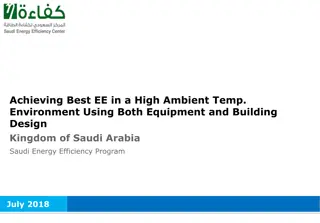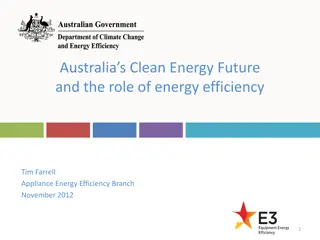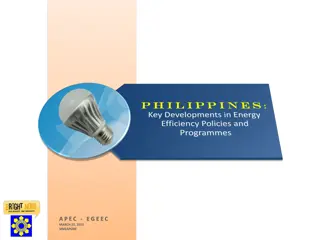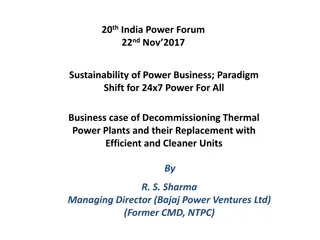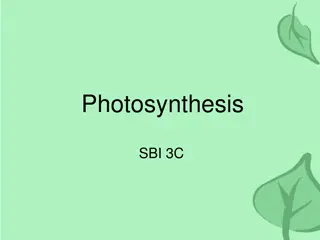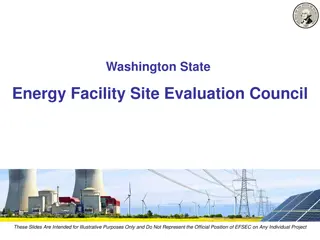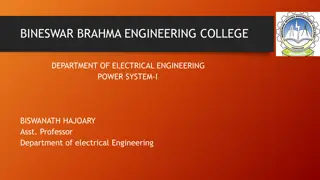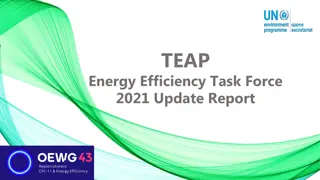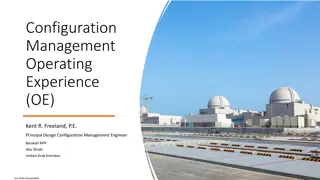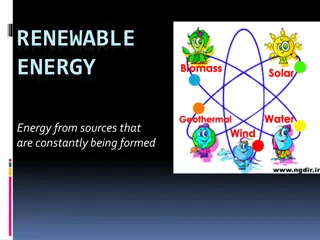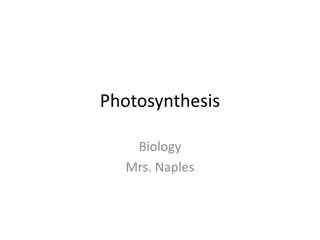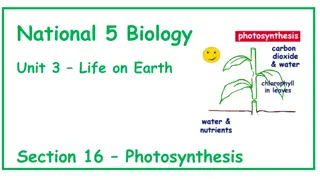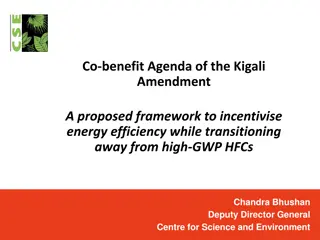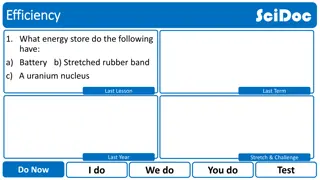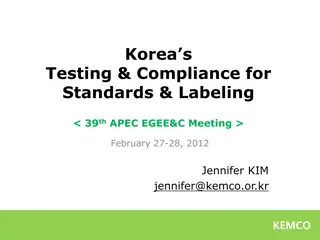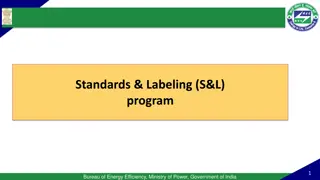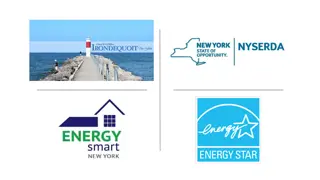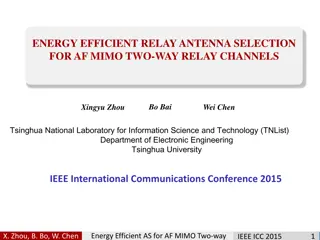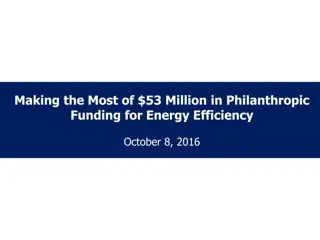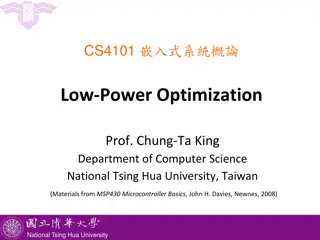Best Practices for Energy Efficiency Improvement in Operating Power Plants
Explore essential guidelines for optimizing energy efficiency in thermal power plants, focusing on regular data analysis, technology advancements, phased improvements, and mindset shifts. Learn about the necessity of efficiency enhancement for financial sustainability, fuel cost savings, and CO2 emission reduction. Discover the critical importance of instrument accuracy and calibration in achieving and maintaining peak performance.
Uploaded on Oct 06, 2024 | 0 Views
Download Presentation

Please find below an Image/Link to download the presentation.
The content on the website is provided AS IS for your information and personal use only. It may not be sold, licensed, or shared on other websites without obtaining consent from the author. Download presentation by click this link. If you encounter any issues during the download, it is possible that the publisher has removed the file from their server.
E N D
Presentation Transcript
Energy Audit & Efficiency Improvement of Operating Power Plants 28 July 2015 Dr. Y. P. Abbi Senior Advisor/Energo Engineering Projects Limited, Ex- Executive Director/BHEL, Senior Fellow/TERI, President/Energo
Energy Efficiency Improvement of Thermal Power Plants It is responsibility of Operation & Maintenance Engineers/Managers of the plant It involves systematic data collection & analysis (weekly/fortnigtly); and not once a year by an External Energy Auditor Understand the science/technology for each equipment sub-system of the plant; and keep yourself abreast with their latest technology development Planned improvements in stages; don t wait for R&M Retire old plants with Heat Rate deviation more than 20 %
Energy Efficiency Improvement A Necessity Power demand (as on date) is low (PLF); thus need for efficiency improvement for financial sustainability Energy efficiency improvement leads to fuel cost saving and thus plant profitability It leads to CO2emission reduction (a national & international commitment)
Change Mindset for Energy Efficiency Improvement Don t make excuse that coal quality has become bad We have to work with the available fuel, and achieve the best possible results Blame no more the design defects; it is we who have to overcome/remove these Don t be defensive while analyzing results, or receiving suggestions from external Energy Auditors Make PG Test results as the baseline; and make all efforts to achieve & maintain these Important that all key instruments used in the plant are calibrated regularly and at least conform to prescribe accuracy
Required Accuracy of Instruments Instrument Accuracy (+/- %) Temp. Range: 0 to 277 0C 1.1 0C; 277 to 1260 0C 3/8 % Thermocouples Pressure Transducers 0.1 Power Meter 0.1 Data Logger 0.03 Power Transducer 0.5 Flue Gas Analyzer 0.5 Ultrasonic Flow Meter 0.5 Anemometer 1.0 Infrared Thermometer 1.0 Lux Meter 1.0 RH Meter 1.0 Calibrated Test Flow Assembly 0.25
LET US CONSIDER THE PATTERN OF ENERGY CONSUMPTION & LOSSES IN A THERMAL POWER STATION
Typical Energy Losses in a Power Plant
You cannot Manage what you cannot Measure (Accurately) - Jack Welch, CEO, General Electric
What needs to be measured for Efficiency Improvement of a Power Plant ? Heat rate of the plant Heat rate of the steam turbine cycle & Boiler Efficiency Auxiliary Power Consumption Net heat rate of the power plant (Monitored by CEA & BEE under PAT scheme)
Heat Rate of Steam cycle and the Power Plant Heat Rate of steam cycle, HRsc = {(Enthalpy of SH steam) +(Heat added during RH) (Sensible heat in feed water)} / (kW electricity generated), kCal/kWh Efficiency of steam cycle, sc = 860 /HRsc Gross Heat Rate of the Power Plant, HRpp = HRsc / BOILER , kCal / kWh Gross Calorific value of Fuel = GCV kCal /kg of fuel Specific fuel consumption = HRpp / GCV, kg/kWh Net Heat rate of the Power Plant = HRpp / (1 APC in fraction)
Perform Achieve & Trade (PAT) scheme under Energy Conservation Act 2001 Applicable for all Designated Consumers (DCs) Thermal Power Plants are also DCs Every DC is given a target for reduction in energy consumption by end of three years For power plants, the target will be in terms of reduction of Net Heat Rate of the Plant Power plants who don t achieve the target will have to buy Energy Certificates from those who have achieved more than their targets
Benefits from Heat Rate Improvement Take the case of a typical 210 MW power plant and assume that it has the following operating variables: Heat rate = 2450 kCal/kWh Plant load factor = 85 % Coal GCV = 3997 kCal/kg (C = 41.7 %) Coal cost = INR 2000 /t CO2 emission per t of coal burnt = (41.07/100) x (44/12) = 1.5059 t The coal consumed and its cost, and CO2 emissions per year are as follows: Specific coal consumption = 2450/3997 =0.613 t/MWh Electricity produced = 210 x 0.85 x 365 x 24 = 1,563,660 MWh Contd.1
Contd. 1 Coal consumed = 1,563,660 x 0.613 = 958,524 t Coal cost = INR 958,524 x 2,000 = INR 1,917,048,000 CO2 emissions = 958,524 x 1.5059 = 1,443,441 t If the energy audit and modifications in O&M practices yields an improvement of heat rate by just 50 kCal/kWh, the fuel and fuel cost saved per year would be as follows: Heat rate (improved to) = 2400 kCal/kWh Specific coal consumption = 2400/3997 = 0.60045 t/MWh Contd. 2
Contd. 2 Coal consumed for generating 1,563,660 MWh of electricity = 1,563,660 x 0.60045 = 938,900 tonne Coal cost = 938,900 x 2000 = 1,877,800,000 INR CO2 emissions = 938,900 x1.5059 = 1,413,890 t Thus, coal cost saved in one year = INR (1,917,048,000 1,877,800,000) = INR 39,248,000 CO2 emissions saved in one year = 1,443,441 - 1,413,890 = 29,551 t
Objectives of an Energy Audit or Performance Monitoring To improve Heat Rate and reduce Auxiliary Power Consumption of the power plant To identify energy efficiency improvement measures To develop medium-term and long-term energy conservation measures, & work out techno-economics
Evaluation of efficiency of Boilers Standards ASME PTC 4 or BS 2885 or IS 8753 Applicable for boilers fired with oil, gas, solid fuels Two Methods used a) Direct Method, & b) Indirect Method Applicable for different firing systems Stoker, pf, FBC Applicable for subcritical and supercritical boilers
Direct Method Boiler efficiency = (Heat output/Heat input) 100 = {Steam flow rate (steam enthalpy feed water enthalpy) 100}/ (Fuel firing rate gross calorific value) *Fuel as fired basis only
Calculation of Boiler Efficiency (ASME PTC 4) Heat losses in the boiler (%) Dry flue gas losses (sensible heat + un-burnt CO) Loss due to hydrogen and moisture in the flue gases Loss due to moisture in air Un-burnt carbon losses (fly ash and bottom ash) Loss due to sensible heat in fly ash and bottom ash Radiation & convection losses from boiler surface Total losses = Sum of all above Boiler Efficiency BOILER = 100 Total losses
Data required for boiler efficiency calculations Ultimate analysis of fuel (C, H, O, N, S, H2O, ash) GCV of fuel, kCal/kg O2 in flue gas (% by vol.) CO in flue gas (% by vol.) Tg, Flue gas temperature, oC Ambient air temp., humidity in air Combustibles (un-burnt) in fly ash & bottom ash Measurement of temp., press., flow should be done at multiple points in the duct
Recommended excess air levels Fuel/Type of boiler Coal PC FBC Stoker Fuel oil Bagasse Wood Blast furnace gas Excess air (%) 15-20 20-25 25-35 03-15 25-35 20-25 15-30
Cold air leakage in an air heater Flue gas to ID fan Flue gas from economizer Air heater Hot air for combustion Air from FD fans
Cold air leakage in Air Heaters As per ASME PTC 4.1 wAL,% leakage = {(% O2 in gas leaving the heater - % O2 in gas entering the heater)/ (21 - % O2 in gas leaving the heater)}x 90
Corrected flue gas temperature leaving the air heater for no leakage tGONL = {% leakage x CpA x (tGO tAI)/ (100 x CpG)} + tGO where CpA = Mean specific heat between temperature tAI and tGO CpG = Mean specific heat between temperature tGO and tGONL
Case study of Energy Audit of a 500 MW Boiler
Case study: Boiler efficiency evaluation for a 500 MW unit (Steam parameters- 1700 t/h, 179 ata,540oC/540oC) Coal properties Design C (Wt %) 37.92 44.73 H 02.33 01.99 S 00.29 00.37 N 00.84 O 06.23 H2O 12.00 Ash 40.39 GCV (kCal/kg) 3500 Actual 00.62 01.83 14.10 36.22 3622
Measured data for energy audit Boiler O2 in flue gas (%) Excess air (%) CO (ppm) Flue gas temp. (OC) Ambient temp. (OC) Wet bulb temp. (OC) Air heater O2 (%) in flue gas after eco. O2 (%) in flue gas after air heater 9.3 167.57 4.01 23.06 23.9 18.1 4.01 7.50
Calculation of boiler efficiency Parameter (%) Dry flue gas loss Heat loss due to CO Heat loss due to moisture in air Heat loss due to moisture and Hydrogen in fuel Heat loss due to unburnt in bottom ash Heat loss due to unburnt in fly ash Sensible heat in bottom ash Sensible heat in fly ash Surface & unaccounted loss Total heat losses Boiler efficiency Design Calculated 5.08 0.00 0.12 8.89 0.00 0.12 5.95 0.90 0.00 0.38 0.18 0.67 12.57 87.43 5.78 0.07 0.02 0.26 0.33 0.10 15.65 84.35
Analysis of boiler efficiency test results Flue gas losses are higher than design Excess air level is 23.6 % (recommended value is 20 %) Flue gas temperature (OC) Measured 167.57 Corrected after applying leakage correction 190.0 Design value 146.0
Expected improvement in boiler efficiency From 190 23.6 84.35 To 146 20.0 87.18* Flue gas temp. (OC) Excess air (%) Boiler efficiency (%) * This would be very close to the design value of 87.43%.
Coal and monetary savings potential through efficiency improvement Current coal consumption (t/y) 2,632,181 Saving potential through efficiency improvement (t/y) Coal cost (INR/t) Monetary savings (INR/y) 148,980,000 74,490 2,000
Energy audit of steam turbines (Data required) Steam flow, temperature and pressure conditions at the entry to the HP turbine Cold reheat steam temperature and pressure Temperature and pressure of hot reheat steam at the inlet of IP turbine Temperature and pressure of IP exhaust steam LPT exhaust pressure Extraction temperature and pressure of steam of all the extractions (6 in case of 500 MW and 5 in case of 210 MW) Super heater and reheater spray conditions (quantity, pressure and temperature) Feed water condition at the economiser inlet (quantity, pressure and temperature) Make up water quantity Coal consumption and power generation
Analysis of steam turbine data = (Heat input to turbine)/Power generated TG heat rate (HR) Heat input to turbine = {Heat in main steam + Heat picked up in reheat + Heat in make-up water + Heat picked up in super heater (SH) spray + Heat in reheater (RH) spray Heat in feed water} Heat picked up in reheat = {HRH flow x (Enthalpy of HRH Steam Enthalpy of CRH steam)} Heat picked up in SH spray = {SH spray quantity x (Enthalpy of SH spray Enthalpy of feed water at economiser inlet)} HRH flow = CRH flow = {MS flow Extraction-6 quantity Gland steam leakages } Assumed as 1.5% of the MS flow to turbine Extraction-6 quantity = { FW flow through HPH-6 (enthalpy in enthalpy out)} / (enthalpy of steam in enthalpy of steam out)
Analysis of steam turbine data (Contd.) TG efficiency = 860/TGHR Plant heat rate = (TGHR/Boiler efficiency)x100 Steam rate (SR) in kgs/kWh is steam input to the turbine (kgs) to actual power output from the turbine (kWh) Specific coal consumption (SCC) in kgs/kWh is overall plant heat rate (kCal/kWh) to the GCV of coal (kCal/kg) on as-fired basis. Cylinder efficiency (HP/IP)= (actual enthalpy drop / isentropic enthalpy drop)x 100 =(steam inlet enthalpy steam outlet enthalpy)/(steam inlet enthalpy Isentropic enthalpy)x 100
Audited performance parameters of a 500 MW steam turbine Parameters Flow (t/h) Pressure (bar) Temperature (OC) Enthalpy (kCal/kg) Isentropic enthalpy (kCal/kg) Main steam 1575.97 169.17 535.08 809.11 - CRH-HPT exhaust 1450.00 46.47 343.49 731.05 721.71 HRH-IPT inlet 1450.00 42.47 530.09 838.87 - IPT exhaust - 6.727 268.39 715.03 707.72 LPT exhaust - 0.096 - 531.02 -
Audited performance parameters of a 500 MW steam turbine (contd.) Parameters Flow (t/h) Pressure (bar) Temperature (OC) Enthalpy (kCal/kg) Isentropic enthalpy (kCal/kg) FW at eco inlet 1580.90 210.02 249.54 259.05 - SH spray 35.17 195.31 314.50 337.81 - RH spray 2.49 115.56 183.94 187.65 - Make-up water 9.74 - 25.00 25.04 - - - - - - -
Audited performance parameters of a 500 MW steam turbine (contd.) Coal consumption 286.66 t/h* Power generation 504.95 MW * Unit control board value
Analysis of performance of steam turbine Parameter Design@0% makeup water Design @3% makeup water PG test value Audited Performance TGHR, kCal/kWh 1988.10 2023.6 1994.38 2030.74 TG efficiency, % 43.26 42.50 43.12 42.35 Boiler efficiency, % 87.43 87.43 88.90 84.35 Plant HR, kCal/kWh 2273.93 2314.54 2243.48 2407.51
Analysis of performance of steam turbine (Contd.) Parameter Design@0% makeup water makeup water Design @3% PG test value Audited Performance Overall plant efficiency, % 37.82 37.16 38.33 35.72 Steam rate, kg/kWh - - - 3.12 GCV of coal, kCal/kg 3500 3500 - 3622 Specific coal consumption, kg/kWh 0.650 0.661 - 0.665 Specific coal consumption, kg/kWh-UCB value - - - 0.568
Cylinder efficiency of three turbines Parameter HPT efficiency (%) IPT efficiency (%) LPT efficiency (%) Overall efficiency (%) 43.12 PG Test 87.24 91.36 56.33 Audit 89.32 94.42 52.29 42.36
Inference & Recommendations SH spray is 2.39%, which is higher than prescribed limit Turbine heat rate of 2030.74 (at 0.63% makeup water)is higher than the design value of 1988.10 Coal consumption as calculated is higher than UCB value. Thus, Gravimetric Feeder needs re-calibration
Inference & Recommendations (Contd. 1) HPT & IPT efficiencies are better than the PG test level. This leads to lesser enthalpy drop in LP cylinder, and thus LP cylinder efficiency is lower. SH spray causes less feed water flow through the water walls (once-thru boiler) and thus affects its performance. RH spray causes less bleed steam flow to the FW heaters and thus loss of efficiency. RH spray also lowers the cycle efficiency as the steam formed by spray water in reheater bypasses the HP cylinder, and thus affects the efficiency.
Inference & Recommendations (Contd. 2) Overall performance of turbine can be improved by reducing the SH and RH sprays by suitably tilting downwards the burners. Maintain recommended condensate levels in FW heaters. With this no heat transfer areas are immersed in the drain condensate. Overall plant efficiency is a function of efficiencies of both boiler and steam turbine. In this case, the improving boiler efficiency can make a major contribution.






